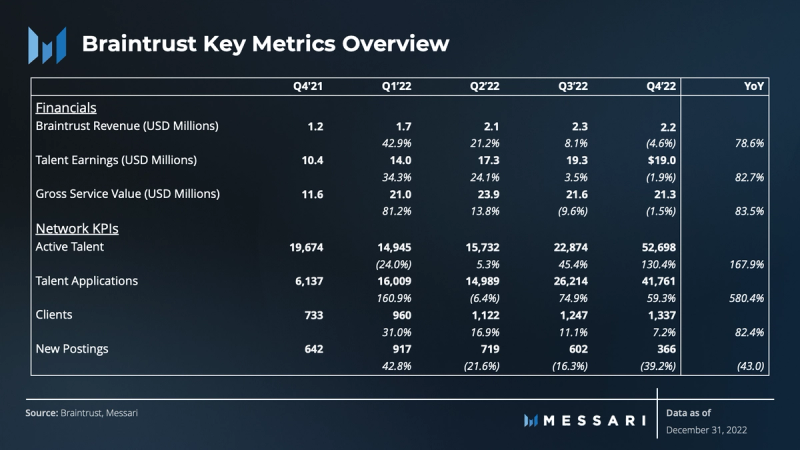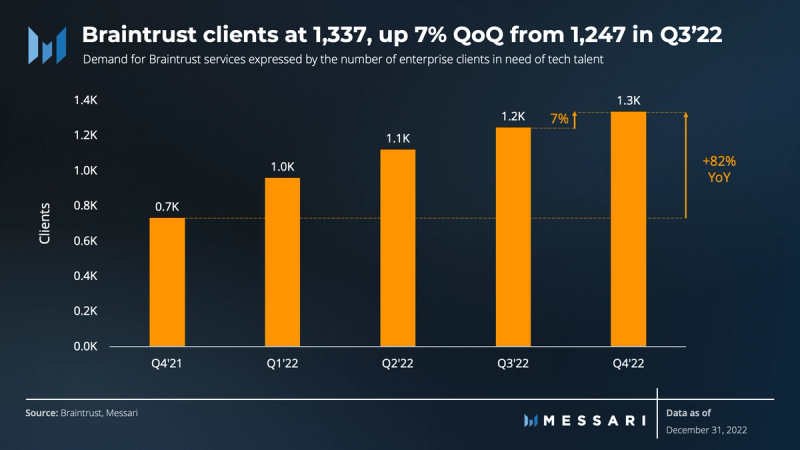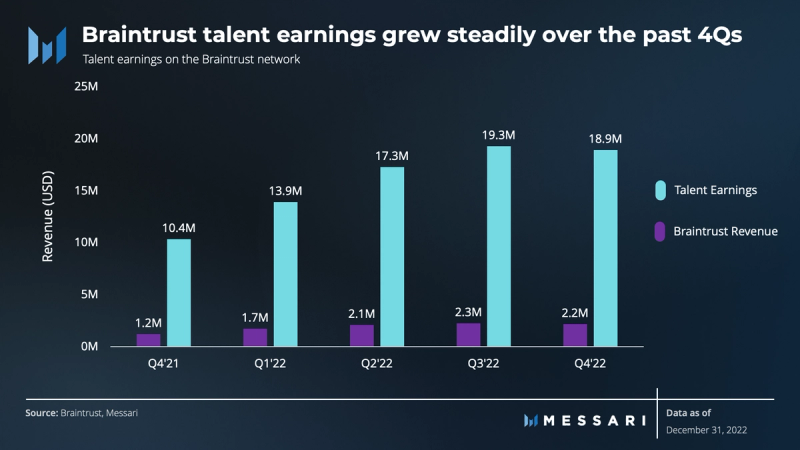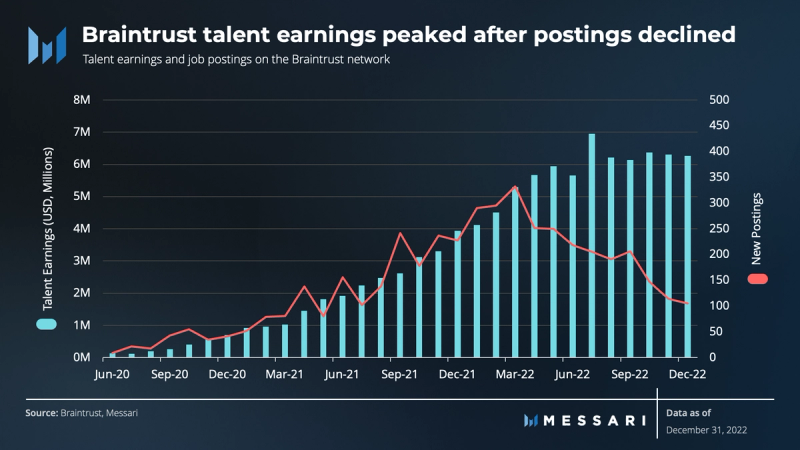Key Insights
- Braintrust is a user-owned network that connects talent with hiring clients via a set of smart contracts and open-source software.
- Q4’22 saw a record supply of 53,000 active talent, up 130% QoQ (up 168% YoY), and 42,000 job applications, up 59% QoQ (up 580% YoY).
- In terms of demand, Q4’22 saw 1,300 Braintrust clients, up 7% QoQ (up 82% YoY). While new job postings declined 39% QoQ due to macroeconomic pressures, average project length increased to 228 days, driven by direct hire placements.
- In Q4’22, talent earnings remained at a solid level, down 2% QoQ to $18.9 million (up 83% YoY) after reaching an all-time high of $19.3 million in Q3’22.
- As of December 2022, Braintrust has facilitated $121 million in cumulative dollar value returned to talent on its platform.
Primer on Braintrust
Braintrust is a decentralized talent network. Although its user experience is similar to traditional talent marketplaces such as Upwork or Toptal, Braintrust is a user-owned network that does not charge talent. Instead, it only charges clients 10%. Braintrust connects talent with hiring clients via a set of smart contracts empowering a permissionless community. Braintrust leverages its native token BTRST to bootstrap client and talent engagement.

The BTRST token serves as the incentive and governance mechanism for the network’s key participants:
- Clients get their fees converted from fiat into BTRST via the fee converter smart contract; clients use BTRST to post jobs when searching for talent on the network.
- Talent uses BTRST to signal job availability or to access token-gated resources.
- Connectors earn BTRST by introducing, referring, and onboarding clients and talent.
All Braintrust stakeholders can earn BTRST, stake them, or participate in governance (e.g., propose new changes to the network or vote on product roadmaps). BTRST is also used as an incentive to complete profiles and finish educational courses on the Braintrust platform.
Key Metrics

Performance Analysis
Usage
Braintrust usage can be analyzed by its activities on both the supply and the demand side of the marketplace:
- Supply: knowledge workers seeking jobs on the Braintrust marketplace.
- Demand: clients posting jobs when in need of the services of talent.
Supply
Braintrust’s network supply can be gauged by the activity of talent and their job applications on the network.

Q4’22 saw an all-time high of nearly 53,000 active talent on the Braintrust network, up 130% QoQ. On a year-over-year basis, the increase was 168% from nearly 20,000 active talent in Q4’21. Activity is defined as talent submitting a job application, referral, or invoice. It also includes talent signing up or viewing a job on the Braintrust network.
To apply for a job, talent undergoes a community-led assessment to determine if the candidate is suitable for the job. Afterward, Braintrust’s algorithm connects the right candidate with the job based on criteria such as skills, experience, availability, and hourly rates.

In Q4’22, talent applications increased substantially given the rough landscape in the tech industry. Applications overall rose 59% (from 26,000 in Q3’22 to nearly 42,000 in Q4’22). On a year-over-year basis, the increase was 580% from over 6,000 active talent in Q4’21. First-time job applications rose 188% QoQ (from 3,600 in Q3’22 to over 10,000 in Q4’22), while incremental job applications rose 39% QoQ (from nearly 23,000 in Q3’22 to over 31,000 in Q4’22). This overall increase in job applications shows a healthy growing supply of talent on the Braintrust network.
Demand
Demand for Braintrust services mostly comes from enterprise clients searching for services supplied by talent. Hiring on Braintrust requires clients to post jobs. Job posts are discovered either by talent or by connectors, who can refer candidates to jobs within their personal network. A recent Messari analysis of talent marketplaces by industry and role can be found here.

In Q4’22, registered clients on the Braintrust network reached 1,337, up 7% QoQ from 1,247 in Q3’22. On a year-over-year basis, the increase was 82% from nearly 733 clients in Q4’21. Relative to the 130% growth in the supply of active talent, the 7% growth in Braintrust clients shows a weakening demand due to the overall macroeconomic conditions.

The weakened demand for labor is illustrated by the decline in new job postings due to macroeconomic pressures on hiring markets. Q4’22 saw 366 new job posts, down 39% QoQ (down 43% YoY). This decrease may suggest that a growing portion of job posts is for longer-term projects and full-time roles. As of December 2022, the average project duration on the Braintrust platform is 228 days, up from 219 days in September 2022. The increase in contract duration may be driven by higher-quality longer-term jobs or by ongoing engagements that do not require a new posting every time talent is sought after.
Revenue
Talent Earnings

Talent earnings showed a steady increase over the first three quarters in 2022, reaching an all-time high of $19.3 million in Q3’22. In Q4’22, talent earnings remained at a solid level, down 2% QoQ to $18.9 million.

The monthly talent earnings remained above $6 million after reaching an all-time high of $6.9 million in July 2022, which occurred four months after the peak in new postings.
This lag can be attributed to Braintrust’s focus on more technical talent, which, in turn, corresponds to a relatively high average length of Braintrust projects — currently at 228 days. Simultaneously, the
overall macroeconomic climate and the recent tech layoffs appear to have had a limited effect on the marketplace, as talent earnings remained at a solid level throughout Q4’22. As of December 2022, the average project size on the Braintrust platform was nearly $88,000.
Braintrust Revenue
In line with talent earnings, Braintrust revenue in Q4’22 remained solid at $2.2 million, down 4% from 2.3 million in Q3’22. Braintrust revenue is accrued after a job is completed and talent is paid the contract value in USD. While the BTRST token doesn’t accrue any network fees, Braintrust takes a flat 10% fee on top of all network transactions (i.e., paid contracts) to sustain its operations and the community. This fee is paid by the client, representing Braintrust’s revenue. On a cumulative basis, Braintrust registered $11.3 million revenue from all network transactions since July 2019.
Notably, Braintrust does not collect any fee from talent. Instead, the 10% flat fee paid by clients in cash is sent to a smart contract (i.e., the fee converter) and used to buy back BTRST from the open market. The acquired BTRST tokens are then deposited to an on-chain pool managed by the Braintrust DAO, thus strengthening its treasury. Braintrust uses this mechanism to incentivize network participants to further build the protocol. At the same time, BTRST accrues value and gets increasingly used in governance.
Network Growth
Gross Service Value
Braintrust measures the Gross Service Value (GSV) to account for the growth of its entire network. The metric represents the actual dollar amount that has come into Braintrust before being distributed to the freelance talent. As per Braintrust’s example, if a client hires three developers billing at $10,000/month, the GSV for the month would be $33,000 ($10,000 x 3 developers + 10% Braintrust fee). It’s worth noting that the GSV takes into account only the dollar amounts that have been paid by the clients upon the completion of the projects.
Gross Contract Value
To account for all the projects that have accepted offers and the anticipated contract value, Braintrust uses Gross Contract Value (GCV). GCV represents all actual and anticipated income into the Braintrust network. For example, if a client hires three developers who are billing at 10,000/month, for a 6 month project, the GCV would be $198,000 ($10,000 x 3 developers x 6 months + 10% Braintrust fee).

As of December 2022, Braintrust has facilitated more than $121 million in cumulative talent earnings since July 2019. Simultaneously, the cumulative GCV was nearly $161 million during the same time span.

On a quarterly basis, while GSV decreased 2%, GCV increased 7%. This relationship shows a steady growth of Braintrust’s network despite headwinds from the tough macroeconomic jobs environment. Braintrust maintains its growth by:
- Focusing on marketplace efficiency and effectiveness.
- Expanding into direct hire placement.
- Upgrading tokenomics to incentivize the full career journey.
Qualitative Analysis
Key Events
USDC Payouts via Stripe Deal
As of Q4’22, Braintrust added a new payout option in USDC using the Stripe Connect service. Braintrust and payments company Stripe reached a deal giving Braintrust talent the option to receive USDC payments.
Clients
Braintrust clients in Q4’22 include important employers such as NASA, TaskRabbit, Nestlé, Porsche, Pacific Life, Ernst & Young, Intel, Coursera, IBM, Dropbox, Meta, Manulife, Gartner, and Dentsply Sirona. Prominent examples of these employers using Braintrust to reach a larger talent pool include:
- Pacific Life boosting its innovation output by efficiently onboarding a talent pipeline.
- Nestlé scaling up its IT team to create a new direct-to-consumer buying experience.
- TaskRabbit using a global tasking machine to scale its engineering team.
Most of the clients get acquired through the Braintrust Connector Program, where community members refer clients and earn BTRST in return.
Trading on Binance.US
As of Q4’22, the Braintrust token (BTRST) can be traded on Binance.US using both crypto and fiat, i.e., BTRST/USDC and BTRST/USD pairs. The BTRST token has been listed on the exchange since September 2022.
Governance
Tokenomics
The total number of BTRST governance tokens is capped at 250 million. The BTRST token distribution is spread across four groups:
- 19% (48 million) reserved for the team and early contributors.
- 22% (55 million) allocated to early investors with a 2-year lock (1-month cliff).
- 54% (135 million) reserved for community incentives and network rewards.
- 5% (13 million) reserved for CoinList public sale.
Voting
Braintrust uses both off-chain and on-chain voting to enact changes to its network. Ideas that receive support in Discord conversations are often turned into change proposals to be voted upon by the community. Off-chain voting occurs on Snapshot and consists of two sub-phases: temperature check (yes/no poll) and consensus check (helps refine a proposal to a concrete solution).
Proposals that require technical implementations or changes to the blockchain’s smart contracts usually require on-chain voting before moving to the execution phase.
There is a time lock period of seven days during which the proposal must be executed. If the results of the on-chain proposal do not suggest a change from the status quo, the topic will be closed. Otherwise, the change suggested in the proposal can be executed on-chain during the seven-day period. Any user can send a transaction to the smart contract to execute the accepted proposal.
Roadmap
Professional Network
In 2023, Braintrust plans to support talent to connect with professionals with similar career goals. This will be achieved through recurring learning engagements, governance, and the creation of goal-focused communities. The Professional Network feature is currently in Alpha testing. The release to the general public is expected in Q1’23.
At a later stage, Braintrust aims to create a single connected experience for talent to own their career through advice, connections, jobs, and goal-oriented learning. These activities will be powered by the BTRST token and governed by the Braintrust community.
Marketplace
In its current state, the Braintrust marketplace features new jobs and fosters talent growth through network liquidity and new talent acquisition. Ongoing development efforts include standardized workflows and tools to generate training data to support automated screening and matching algorithms. Braintrust is currently looking for new ways to incentivize its network and distribute ownership. In 2023, Braintrust plans to expand its client base and scale its product-market fit.
Closing Summary
Although its network is still young compared to incumbents, Braintrust has attained product-market fit. To date, Braintrust has facilitated $121 million in cumulative dollars in talent earnings. In Q4’22, talent earnings remained at a solid level, down 2% QoQ to $18.9 million after reaching an all-time high of $19.3 million in Q3’22.
Braintrust continues to align both the demand and supply side of the network. Q4’22 saw a record supply of nearly 53,000 active talent on the Braintrust network, up 130% QoQ, and nearly 42,000 job applications, up 59% QoQ. In terms of demand, Q4’22 saw over 1,300 clients on the Braintrust network, up 7% QoQ.
While Braintrust is certainly a long way from rivaling established talent marketplaces, its continued growth is promising. It sets a precedent for how Web3 two-sided marketplaces could outcompete existing incumbents. Braintrust continues to focus on market efficiency and effectiveness, expansion into direct hire placement, and platform innovation across the full career journey.
Because Braintrust’s talent network mostly operates on the human layer, the protocol must take extra care in its governance model. Although most DAOs have to deal with challenges, Braintrust is unique in that it can’t solely rely on code to solve its issues.
Despite its solid start, Braintrust faces the same challenge that many Web3 protocols face: scaling enough to truly challenge the incumbent players. In today’s digital job market, there is fierce competition to onboard the most talented knowledge workers. To carve out its place in the competition, Braintrust will have to onboard more clients and host more job postings on its platform.




















